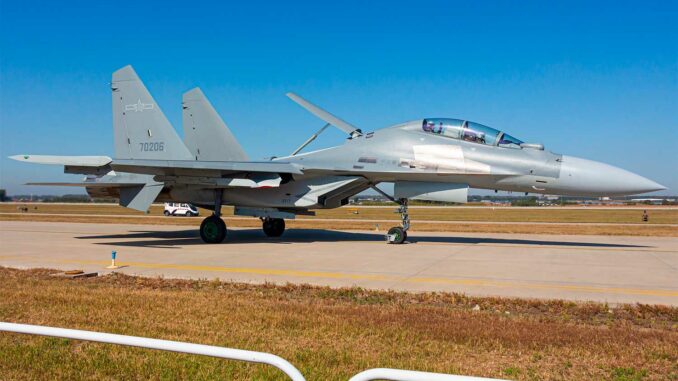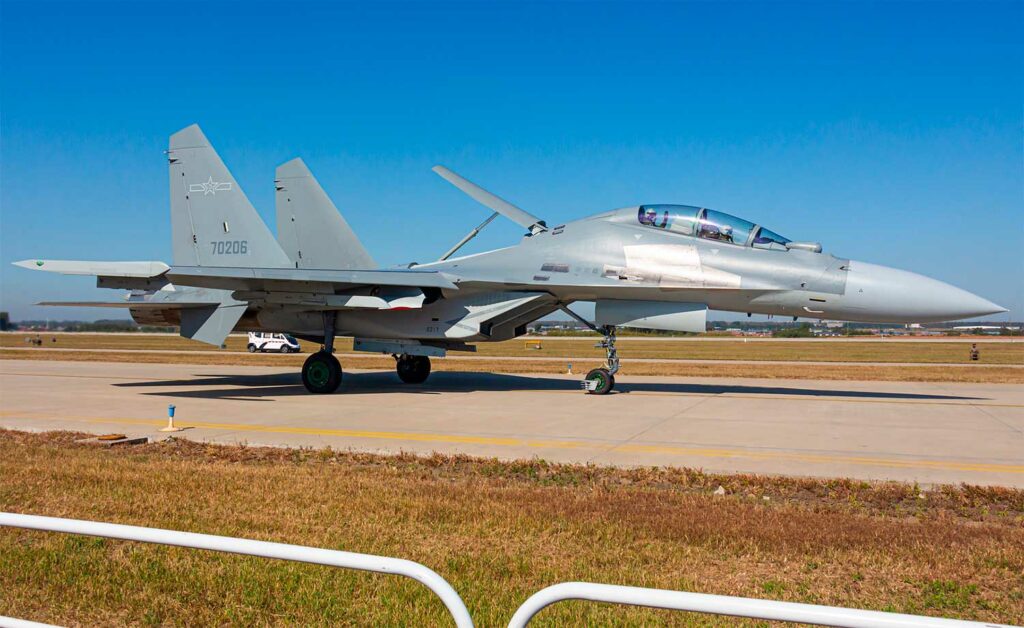
In 2024, PLAAF J-16s reportedly intercepted two foreign stealth aircraft over the South China Sea, illustrating rising regional tensions.
Summary
A report in the South China Morning Post revealed that J-16 fighters from the People’s Liberation Army Air Force (PLAAF) intercepted and forced two foreign stealth aircraft—presumably American or allied—to turn back during incidents in 2024 over the South China Sea . The event highlights the central role of the J-16 in Chinese air defense, capable of detecting and deterring intrusions by advanced aircraft such as the F-35 or F-22. This episode illustrates the intensification of strategic competition in this disputed maritime zone, where the naval and air forces of the United States and its allies are confronting China’s rise to power. It also raises questions about the technological limitations of stealth fighters when operating in sensor-saturated environments under high surveillance.
An incident revealing regional tensions
According to the South China Morning Post, two interceptions took place in 2024, involving foreign stealth aircraft entering areas that Beijing considers to be within its air defense zone. China claims a large part of the South China Sea, through which more than $3 trillion worth of goods pass each year. These claims are contested by several coastal states and are not recognized by international law, but they are central to China’s defense policy in the region.
The regular presence of US and allied reconnaissance aircraft—such as the P-8 Poseidon, RC-135, and sometimes stealth fighters—reflects Washington’s desire to ensure freedom of navigation and overflight in this strategic area. The 2024 interceptions, which have not been confirmed by the Pentagon, nevertheless testify to the growing friction between US patrols and Chinese forces, which are now better equipped and more responsive.
The J-16, the backbone of Chinese interceptions
The Shenyang J-16 is a 4.5-generation two-seat multirole fighter derived from the Russian Su-30MKK, but extensively modified by the Chinese industry. Entering service in 2015, it is now considered one of the PLAAF’s main air defense vectors.
The J-16 is equipped with a domestic AESA radar, WS-10B engines that are more reliable than the initial versions, and modern electronic warfare systems. It can carry a wide range of air-to-air weapons such as the PL-15 (estimated range of over 200 km) and PL-10 for close combat.
The J-16 airframe is not stealthy, but its combination of long-range sensors and electronic warfare systems allows it to intercept targets from a distance. Its ability to cooperate with other platforms—KJ-500 early warning aircraft, ground radars, and tactical data networks—partially compensates for its lack of stealth and makes it a key asset in countering intrusions.
The challenges of detecting stealth aircraft
The interceptions in 2024 highlight the evolution of Chinese detection capabilities. Stealth fighters such as the F-35 Lightning II and F-22 Raptor are designed to reduce their radar signature, but they are not invisible.
China has invested heavily in low-frequency radars (VHF and UHF) and sensor networks distributed across artificial islands and frigates. These radars are less accurate but better able to detect anomalies produced by stealth aircraft at long range.
Once detected, these aircraft must be tracked and designated to more accurate radars to enable the guidance of long-range air-to-air missiles such as the PL-15. The effectiveness of this chain depends on coordination between land, naval, and air sensors, an area in which Beijing has made significant progress over the past decade.

A political signal in a tense strategic context
The revelation of these incidents is not insignificant. It comes at a time when the United States has stepped up its air and sea patrols as part of its commitments to the Philippines and other regional allies.
For Beijing, these interceptions demonstrate its ability to defend what it considers its sovereign space. They also serve as a deterrent message to external powers conducting surveillance or presence missions in the region.
For Washington and its allies, these incidents are a reminder of the risk of tactical misunderstandings that could escalate into confrontation. The increase in these interactions heightens the need for direct military communication mechanisms to prevent accidental escalations.
The role of interceptions in Chinese doctrine
The PLAAF has gradually increased the pace and complexity of its interception and patrol missions over the South China Sea. These operations aim to create an access denial bubble (A2/AD) designed to discourage foreign forces from approaching areas claimed by China.
The J-16, with its ability to carry long-range missiles and operate under the control of early warning aircraft, is particularly suited to this role. Combined with surface-to-air systems such as the HQ-9B, it contributes to a layered defense designed to complicate allied operations in the region.
This strategy is part of Beijing’s broader desire to transform the PLAAF from a force focused on territorial defense into a regional projection air force capable of supporting Chinese interests within a radius of several thousand kilometers.
Implications for the regional military balance
The 2024 interceptions illustrate the narrowing technological gap between China and the United States in air defense. While the F-35 retains an advantage in stealth and connectivity, the J-16 shows that Chinese systems are now capable of threatening advanced aircraft operating near their defense zones.
This forces US and allied forces to adapt their tactics, making greater use of reconnaissance drones and increasing jamming devices to reduce their exposure.
For ASEAN countries, these events highlight the fragility of the regional situation and the need to maintain channels of military dialogue between Beijing and Washington in order to limit the risk of serious incidents.
An indicator of future developments in aerial warfare
The incidents reported in 2024 reveal a broader trend: the reduction of the strategic advantage offered by stealth in heavily monitored environments. The integration of multi-band radar networks, drones, and real-time command systems tends to make it more difficult for advanced aircraft to infiltrate undetected.
This could influence the future development of 6th generation fighters, which will need to combine increased stealth, electronic countermeasures, and collaborative warfare to maintain a significant advantage.
The confrontation in the South China Sea thus illustrates the changing balance of air power and the growing role of detection and command architectures in the regional strategic equilibrium.
A revealing episode in Sino-American competition
The expulsion of two foreign stealth aircraft by Chinese J-16s does not constitute a decisive military turning point, but it illustrates the reality of an increasingly open technological and strategic competition.
It highlights China’s willingness to actively defend its claims and the United States’ desire to continue testing Beijing’s responsiveness and limits in disputed areas.
In this standoff, technology, crew training, and information control are becoming decisive factors, while the risk of incidents increases as the capabilities of both sides converge.
War Wings Daily is an independant magazine.